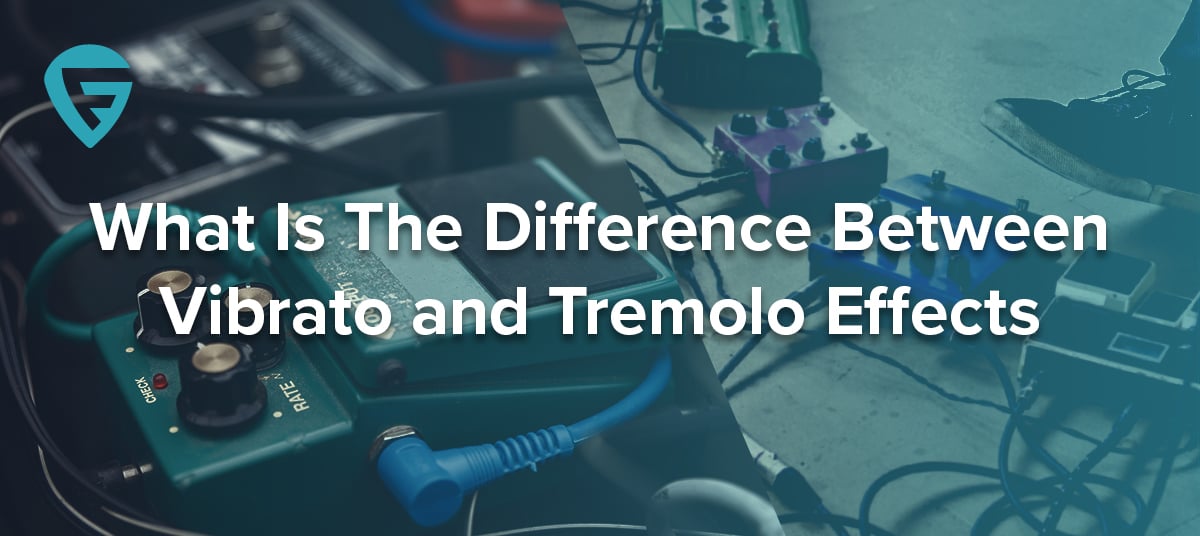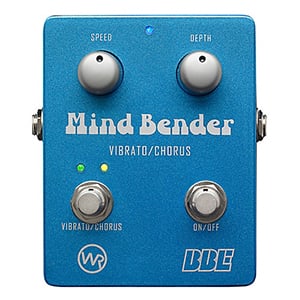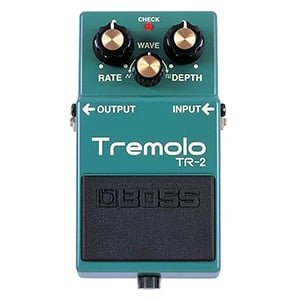- Home
- Instruments
- Gear
- Recording
- Lessons
- Reviews
- Blog

If there are any two guitar effects that get confused for one another, it's the vibrato and tremolo. For the most part, this confusion comes from the fact that these two effects are extremely similar. However, there is still one big difference that separates them.
Today we are going to touch on this matter that seems to be giving trouble to a lot of guitar players out there, and some pedal manufacturers as well. Hopefully by the time we are done with this article, you will have full understanding of what a vibrato effect is, and what a tremolo effect is. It turns out that a lot of people were turned off from using both of these just because they got the wrong one, and tried to make it work in ways it was never meant to be used.
 The most basic way to explain a vibrato effect would be to imagine a whammy bar on your guitar, only in a form of a pedal. As you probably know, a whammy bar works by forcing the bridge to put more or less strain on the strings. That in turn changes the pitch of the strings in one direction or the other. Pitch is the key operating word here. A vibrato pedal creates that whammy effect by also changing the pitch of your signal. There are several benefits to this principle of operation. For starters, you don't have to worry about adjusting the tempo of the effect that much as you do with a tremolo pedal. Secondly, the effect itself sounds a lot more natural since pitch shifting is something that is a common practice for a lot of guitar players.
The most basic way to explain a vibrato effect would be to imagine a whammy bar on your guitar, only in a form of a pedal. As you probably know, a whammy bar works by forcing the bridge to put more or less strain on the strings. That in turn changes the pitch of the strings in one direction or the other. Pitch is the key operating word here. A vibrato pedal creates that whammy effect by also changing the pitch of your signal. There are several benefits to this principle of operation. For starters, you don't have to worry about adjusting the tempo of the effect that much as you do with a tremolo pedal. Secondly, the effect itself sounds a lot more natural since pitch shifting is something that is a common practice for a lot of guitar players.
There are two major types of vibrato pedals out there. You have your analog units, and your digital ones. Analog vibratos are often considered to be the more optimal solution, which explains why some of the most iconic vibrato pedals come in analog format.
This comes from the fact that analog pitch shifting has warmth to it, and clinical precision that digital pedals just can't seem to reach completely. On the other hand, digital vibratos expand the range of possibilities with various additional features. If you would like to know more about how vibratos work, check out our article that deals with that subject in detail. ‘How Does a Vibrato Pedal Work?' Now that we briefly discussed vibratos, let's take a look at tremolo pedals for a moment.
 Remember how we said that vibratos work based on pitch shifting the signal? Well, tremolo pedals achieve a very similar effect to vibratos, but they actually modulate the volume of the signal, and not its pitch. This is a significant difference. When you alter the volume of the signal, the tone of the guitar remains in the same pitch, but you get that choppy or wavy effect, depending on what type of wave form you have selected. To most people, tremolos sound pretty artificial compared to vibratos. This perception is mostly true, which becomes apparent the moment you put these two effects in the same signal chain, and test them both out in succession.
Remember how we said that vibratos work based on pitch shifting the signal? Well, tremolo pedals achieve a very similar effect to vibratos, but they actually modulate the volume of the signal, and not its pitch. This is a significant difference. When you alter the volume of the signal, the tone of the guitar remains in the same pitch, but you get that choppy or wavy effect, depending on what type of wave form you have selected. To most people, tremolos sound pretty artificial compared to vibratos. This perception is mostly true, which becomes apparent the moment you put these two effects in the same signal chain, and test them both out in succession.
The issue with modulating volume comes from the fact that the effect produced that way is a lot more obvious. Let's say you are playing in a band, and there's a section you need to play with a layer of tremolo on top. Since it's so obvious, a tremolo altered signal will cut through the mix with no problems. While this might sound like a good thing, which it generally is, it leads to a different problem. In order to use a tremolo efficiently, you have to match the speed of the effect with the tempo of the song you are playing. Truth be told, that is something you would have to pay attention to with vibratos as well, but it's not as pronounced as it is with tremolos.
At the end of the day, understanding the difference between a vibrato and tremolo is an important aspect of building the type of tone you want. These two effects are so similar but so different at the same time, that it's no wonder people often mistake them. Hopefully this short explanation of these two effects has cleared up whatever misconceptions you have had about them, and now you can walk into a studio without worrying whether or not you will be able to recognize the difference.
You would be surprised how many guitar players around the world use both the tremolo and vibrato effects without knowing how they work, or what is it that sets them apart. We encourage you to additionally explore this subject, and learn more about vibratos in general. It's definitely an effect that can change your tone for the better.

Reader Interactions